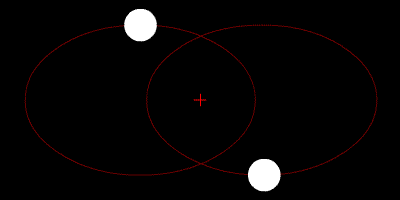
58534 Logos
Encyclopedia
58534 Logos is a small Kuiper-belt object
, more specifically a cubewano, notable for having a comparatively large satellite
named Zoe. For a small, about 80 km in diameter, KBO it has a very high albedo
. The system mass is 4.58 ± 0.07 kg.
In the Gnostic tradition, Logos
and Zoe
are a paired emanation of the deity, and part of its creation myth.
 Logos is a binary
Logos is a binary
with the components of comparable size orbiting the barycentre on a moderately elliptical orbit.
Logos' companion was discovered on 17 November 2001 from Hubble Space Telescope
observations by K. S. Noll, D. C. Stephens, W. M. Grundy, J. Spencer
, R. L. Millis, M. W. Buie
, D. Cruikshank, S. C. Tegler, and W. Romanishin and announced on 11 February 2002.
After the discovery, it received the provisional designation S/2001 (58534) 1. Once confirmed it was officially named (58534) Logos I Zoe . It orbits Logos with a semi-major axis of 8217 ± 42 km in 309.9 ± 0.2 d with an eccentricity
of 0.546 ± 0.008. Its estimated diameter is 66 km, and mass (0.15 ± 0.02) kg.

Kuiper belt
The Kuiper belt , sometimes called the Edgeworth–Kuiper belt, is a region of the Solar System beyond the planets extending from the orbit of Neptune to approximately 50 AU from the Sun. It is similar to the asteroid belt, although it is far larger—20 times as wide and 20 to 200 times as massive...
, more specifically a cubewano, notable for having a comparatively large satellite
Natural satellite
A natural satellite or moon is a celestial body that orbits a planet or smaller body, which is called its primary. The two terms are used synonymously for non-artificial satellites of planets, of dwarf planets, and of minor planets....
named Zoe. For a small, about 80 km in diameter, KBO it has a very high albedo
Albedo
Albedo , or reflection coefficient, is the diffuse reflectivity or reflecting power of a surface. It is defined as the ratio of reflected radiation from the surface to incident radiation upon it...
. The system mass is 4.58 ± 0.07 kg.
In the Gnostic tradition, Logos
Logos
' is an important term in philosophy, psychology, rhetoric and religion. Originally a word meaning "a ground", "a plea", "an opinion", "an expectation", "word," "speech," "account," "reason," it became a technical term in philosophy, beginning with Heraclitus ' is an important term in...
and Zoe
Zoe
Zoe or Zoey may refer to:-People:* Zoe , an indigenous tribe of the Brazilian Amazon* Zoe Zaoutzaina, Byzantine empress* Zoe Karbonopsina, Byzantine empress* Zoe , Empress of the Byzantine Empire with co-rulers 1028–1050.-Music:...
are a paired emanation of the deity, and part of its creation myth.
Zoe

Binary asteroid
A binary asteroid is a system of two asteroids orbiting their common center of mass, in analogy with binary stars. 243 Ida was the first binary asteroid to be identified when the Galileo spacecraft did a flyby in 1993...
with the components of comparable size orbiting the barycentre on a moderately elliptical orbit.
Logos' companion was discovered on 17 November 2001 from Hubble Space Telescope
Hubble Space Telescope
The Hubble Space Telescope is a space telescope that was carried into orbit by a Space Shuttle in 1990 and remains in operation. A 2.4 meter aperture telescope in low Earth orbit, Hubble's four main instruments observe in the near ultraviolet, visible, and near infrared...
observations by K. S. Noll, D. C. Stephens, W. M. Grundy, J. Spencer
John Spencer
-Earls:*John Spencer, 1st Earl Spencer *John Spencer, 3rd Earl Spencer , British politician*John Spencer, 5th Earl Spencer , British politician...
, R. L. Millis, M. W. Buie
Marc W. Buie
Marc W. Buie is an astronomer at Lowell Observatory in Flagstaff, Arizona. He grew up in Baton Rouge, Louisiana and went on to get a B.S. in Physics from Louisiana State University in 1980. After that he switched fields and earned his Ph.D. in Planetary Science from the University of Arizona in...
, D. Cruikshank, S. C. Tegler, and W. Romanishin and announced on 11 February 2002.
After the discovery, it received the provisional designation S/2001 (58534) 1. Once confirmed it was officially named (58534) Logos I Zoe . It orbits Logos with a semi-major axis of 8217 ± 42 km in 309.9 ± 0.2 d with an eccentricity
Orbital eccentricity
The orbital eccentricity of an astronomical body is the amount by which its orbit deviates from a perfect circle, where 0 is perfectly circular, and 1.0 is a parabola, and no longer a closed orbit...
of 0.546 ± 0.008. Its estimated diameter is 66 km, and mass (0.15 ± 0.02) kg.
Orbit

External links
- Orbital simulation from JPL (Java) / Ephemeris
- IAUC 7824
- IAUC 7959

